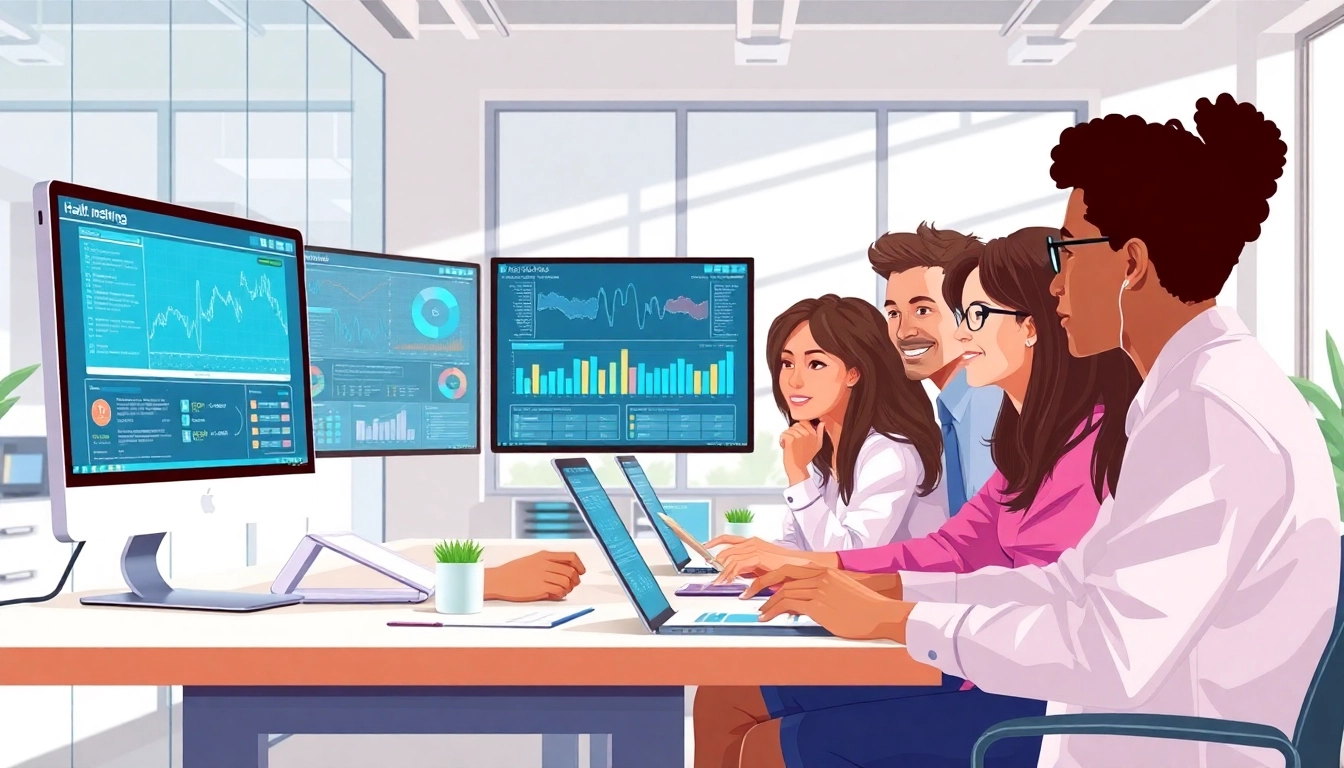Understanding Health Informatics
Defining Health Informatics and Its Importance
Health informatics is an interdisciplinary field that utilizes information technology and data analysis to enhance various aspects of healthcare delivery. It encompasses the design, development, and application of systems that capture, store, manage, and analyze health information. The significance of health informatics cannot be overstated, as it plays a critical role in improving patient outcomes, streamlining healthcare processes, and fostering effective communication between healthcare professionals.
The primary goal of health informatics is to optimize the management of health information, which ultimately supports clinical decision-making. This integration of data helps in identifying trends, predicting outcomes, and facilitating better patient care. Moreover, health informatics promotes the collection of accurate and standardized health data, enabling healthcare organizations to assess their performance systematically and make informed strategic decisions. For further exploration of the role of informatics in improving health services, visit www.informaticsview.com.
Key Technologies in Health Informatics
Several key technologies underpin the field of health informatics, each contributing to enhanced functionality and efficiency within healthcare systems:
- Electronic Health Records (EHRs): EHRs are digital versions of patients’ paper charts, providing real-time access to patient data for healthcare providers. They facilitate improved accuracy, security, and patient care by making information readily available.
- Telemedicine: This technology allows healthcare professionals to diagnose and treat patients remotely. Telemedicine applications have gained immense popularity, especially in response to the COVID-19 pandemic, enabling safer access to healthcare services.
- Health Information Exchange (HIE): HIE allows for electronic sharing of health information across different organizations. This interoperability ensures that healthcare providers can access comprehensive patient records, enhancing coordination and continuity of care.
- Clinical Decision Support Systems (CDSS): These systems provide healthcare providers with clinical knowledge and patient-specific information to facilitate decision-making. By leveraging artificial intelligence, they help clinicians deliver high-quality care based on evidence-based practices.
- Wearable Devices: Devices like fitness trackers and smartwatches have become popular tools for monitoring health metrics, allowing for proactive healthcare management and improved patient engagement.
Common Challenges in the Field
Despite its many benefits, health informatics also faces several challenges:
- Data Privacy and Security: With the digitization of health records, concerns regarding data breaches and unauthorized access have heightened. Ensuring compliance with regulations such as HIPAA (Health Insurance Portability and Accountability Act) is paramount.
- Interoperability Issues: The lack of standardized data formats can hinder effective information sharing among disparate healthcare systems, complicating efforts to achieve seamless patient care.
- Resistance to Change: Healthcare professionals may be reluctant to adopt new technologies due to perceived complexity or inadequate training. Change management strategies are essential to facilitate the transition and train staff effectively.
- High Implementation Costs: Investing in advanced healthcare informatics systems can be expensive, posing a barrier for smaller practices and healthcare organizations.
Applications of Informatics in Healthcare
Improving Patient Care with Informatics
Health informatics has a direct impact on enhancing patient care through various applications. For instance, the implementation of EHRs enables healthcare professionals to access a patient’s medical history, medication records, and test results instantaneously, providing a comprehensive view of their health status. This accessibility ensures timely and informed decision-making during patient encounters.
Moreover, informatics facilitates communication between healthcare providers and patients. Patient portals, for example, allow patients to access their medical records, schedule appointments, and securely message their healthcare providers, fostering a collaborative approach to healthcare management.
Data Management and Analysis Techniques
Effective data management is critical in health informatics. It encompasses the practices used to collect, store, and analyze health data. Here are some techniques that are vital in this domain:
- Data Mining: This process involves extracting patterns and knowledge from large datasets. In healthcare, data mining can identify adverse drug reactions, predict patient readmissions, or uncover trends in disease outbreaks.
- Predictive Analytics: By utilizing algorithms and statistical models, predictive analytics helps healthcare organizations forecast patient outcomes and optimize resource allocation. This proactive approach can enhance the delivery of care.
- Natural Language Processing (NLP): NLP allows for the analysis of unstructured text data, such as clinical notes or discharge summaries. This technology can extract valuable insights from vast amounts of textual data, enhancing the understanding of patient cases.
Examples of Successful Implementations
Several organizations have successfully implemented health informatics solutions, leading to significant improvements in patient care:
- Mayo Clinic: By integrating a robust EHR system, Mayo Clinic enhanced its data-sharing capabilities, allowing specialists across disciplines to collaborate effectively. This integration resulted in more coordinated care and better patient outcomes.
- Cleveland Clinic: The Cleveland Clinic utilized telemedicine platforms to extend its services to remote areas. Patients could consult with specialists without traveling long distances, which was particularly beneficial during the pandemic.
- U.S. Department of Veterans Affairs (VA): The VA’s use of Health Information Exchange improved collaboration between various healthcare facilities, ensuring veterans received continuous and comprehensive care.
Trends Shaping the Future of Health Informatics
Artificial Intelligence and Machine Learning
Artificial Intelligence (AI) and Machine Learning (ML) are at the forefront of transforming health informatics. These technologies can analyze vast datasets quickly, uncover hidden patterns, and support clinical decision-making. For example, AI algorithms can predict patient deterioration, personalize treatment plans, and enhance diagnostic accuracy, ultimately leading to better patient care.
Emerging AI applications are also improving operational efficiency by streamlining administrative tasks, such as appointment scheduling and billing processes. This allows healthcare professionals to devote more time to direct patient care, enhancing overall service delivery.
The Role of Telemedicine
Telemedicine has gained unprecedented prominence in recent years, primarily driven by the need for safe healthcare delivery during the COVID-19 pandemic. Its ability to provide remote consultations has made healthcare more accessible, particularly for patients in rural or underserved areas.
As telemedicine technology continues to evolve, it is expected to play a significant role in chronic disease management, mental health services, and follow-up care. By integrating telehealth solutions within existing health informatics frameworks, healthcare providers can achieve comprehensive and patient-centered care.
Emerging Standards and Protocols
As the health informatics landscape evolves, standardization becomes increasingly critical. Emerging standards such as FHIR (Fast Healthcare Interoperability Resources) are paving the way for seamless data exchange between healthcare systems. FHIR provides a consistent framework for sharing health information, which is essential for achieving interoperability.
Adopting these emerging standards will allow healthcare providers to access complete patient data efficiently, reducing the chances of errors and enhancing care coordination across different settings.
Evaluating Informatics Solutions
Metrics for Success in Health Informatics
To assess the effectiveness of health informatics solutions, healthcare organizations must develop relevant metrics. Metrics might include:
- Patient Satisfaction Scores: Measuring the patient experience can provide insights into the impact of informatics solutions on care delivery.
- Clinical Outcomes: Monitoring metrics such as readmission rates and treatment success can help evaluate the effectiveness of informatics tools.
- Operational Efficiency: Analyzing workflow improvements, cost savings, and time reductions resulting from implemented solutions can demonstrate the value of informatics in delivering care.
Comparing Different Health Informatics Tools
When evaluating health informatics tools, organizations must consider several factors: usability, compatibility with existing systems, scalability, and customer support. Conducting thorough market research is crucial for identifying the best solutions tailored to specific clinical needs.
It’s also beneficial to consider feedback from current users to understand the practical implications of each tool’s implementation, ensuring that the chosen solution aligns with organizational goals.
User Feedback and Continuous Improvement
Healthcare informatics is not a set-it-and-forget-it domain. Organizations must prioritize user feedback to identify strengths and pinpoint areas for improvement. Regularly scheduled assessments and surveys of end users can foster a culture of continuous improvement, facilitating updates and upgrades to enhance system capabilities.
Engaging with users—both clinical and administrative—ensures that the tools are not only efficient but also user-friendly, ultimately leading to higher engagement and better patient care outcomes.
Career Opportunities in Health Informatics
Job Roles and Responsibilities
The growth of health informatics has spurred a demand for diverse professionals within the field. Some common roles include:
- Health Informatics Specialist: These professionals leverage information technology to manage healthcare data, enhancing the quality and efficiency of patient care.
- Clinical Data Analyst: Responsible for analyzing clinical data to inform decision-making and improve outcomes, these analysts provide insights that directly impact patient care.
- Health IT Project Manager: Project managers oversee the implementation of health informatics solutions, ensuring that projects are completed on time and within budget.
- Chief Information Officer (CIO): Higher-level executives set the strategic direction for health IT initiatives within an organization, ensuring alignment with broader healthcare goals.
Skills Required for Success
To excel in health informatics roles, professionals must possess a mix of technical and soft skills, including:
- Analytical Skills: Professionals must analyze data sets to generate meaningful insights that inform patient care strategies.
- Technical Proficiency: Familiarity with EHR systems, database management tools, and other relevant technologies is crucial.
- Communication Skills: Being able to convey technical information to non-technical stakeholders is vital for promoting understanding and cooperation.
- Problem-Solving Abilities: Professionals need to identify challenges and develop effective solutions within complex healthcare environments.
Resources for Professional Development
To stay current in the ever-evolving field of health informatics, professionals should take advantage of numerous resources, including:
- Professional Associations: Organizations such as the American Medical Informatics Association (AMIA) and Health Information and Management Systems Society (HIMSS) offer a wealth of resources, including certifications, networking opportunities, and knowledge sharing.
- Online Courses: Educational platforms provide courses ranging from introductory to advanced topics in health informatics. These can help professionals strengthen their expertise and skills.
- Conferences and Webinars: Participating in industry events enables networking, learning from experts, and staying informed about emerging trends in health informatics.















Leave a Reply